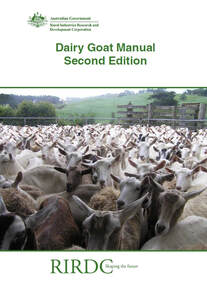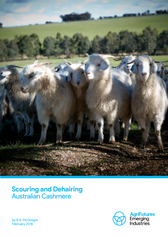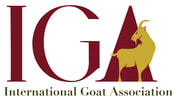|
Author(s): Deborah S. Finlaison, Peter D. Kirkland
Special thanks to Sandra Baxendell (IGA member, Australia) for bringing this report to our attention. Caprine arthritis encephalitis (CAE) is an important disease in goats and can have a profound impact on dairy goat production. It usually presents as a slowly progressing, chronic debilitating disease of adult animals, but in some breeds severe, acute encephalitis may be encountered in kids at a very young age. CAEV infections can have a significant impact on animal welfare due to the chronic nature of the diseases that may develop (arthritis, pneumonia, mastitis), and economically results in decreased animal lifespan and production, premature culling and trade restrictions. CAE was first recognised in Australia in the 1980s, and while the current prevalence is unknown, it is present in dairy herds in all states. It is considered that the proportion of infected herds may now be much lower than 20 years ago, but with a trend towards larger, more intensively managed herds, the individual animal prevalence could rise quickly. Accreditation programs run in some states, and along with eradication activities, are voluntary in nature and not nationally co-ordinated. This report evaluates different diagnostic tests and sample types from naturally and experimentally infected animals to identify more cost-effective testing strategies that can be offered to the dairy goat industry in Australia. CAEV is an eradicable disease, and this research aims to support CAEV eradication at the individual herd and potentially national herd level. Visit the AgriFutures website to purchase a copy
1 Comment
 Meredith Dairy is a family-owned enterprise in southern Australia, milking 10,000 does and manufacturing cheese and yogurt in a purpose-built facility on the farm. The farm and manufacturing enterprise is the venue for some significant goat dairy research under the supervision of Dr. Alexander (Sandy) Cameron and his wife Julie (IGA Country Representative for Australia) This summer, the Dairy was visited by the Republic of Botswana High Commissioner to Australia and former Member of Botswana Parliament, Dorcas Kobela Makgato along with Counsellor Mr. Kesegofetse Unoda Mazongo and other delegates from Botswana. Her Excellency, Ms. Dorcas Kobela Makgato was the former Minister for Trade and Industry in Botswana and has strived to make Botswana an attractive place to do business. She was also a Minister for Health and an advocate for the equality and protection of women. The Ambassador spoke of fond memories of farming and said the farm and animals reminded her of Botswana, family, and her childhood. The Commissioner wrote about her visit on social media, which reached wonderful feedback from the people of Botswana who are excited about the possibilities of Dairy goat Farming.  by Gaille Abud (IGA member) and Arthur Stubbs Foreword This revised edition of the “Dairy Goat Manual” was compiled as a guide to current recommended dairy goat farm management practices based on observations and information gained during the course of the RIRDC project “Farming and Marketing Goat and Sheep Milk Products”. Information contained in this Manual is provided as general advice only. For application to specific situations, professional advice should be sought. RIRDC and its research agents have taken all reasonable steps to ensure that the information in these publications is accurate at the time of publication. Readers should ensure that they make appropriate enquiries to determine whether new information is available on the particular subject matter. The project was funded from RIRDC Core Funds which are provided by the Australian Government. This report, an addition to RIRDC’s diverse range of over 1800 research publications, forms part of our New Animal Products R&D program, which aims to accelerate the development of viable new animal industries. Most of our publications are available for viewing, downloading or purchasing online through our website:
Peter O’Brien Managing Director Rural Industries Research and Development Corporation Watch this great video about Meredith Dairy and IGA members, Julie and Sandy Cameron.
"Firm values and a focus on sustainability have helped ensure the success of Meredith Dairy’s goat cheese both locally and in the export market."  Associate Editor for Hair and Wool Bruce McGregor has devoted his life to animals, environmental management and community organizations. Bruce has training in agriculture, land management, wool science, textiles and organization leadership. He has investigated animal production systems in advanced technology societies and subsistence transhumance societies including products from superfine Merino sheep, Angora goats, cashmere goats, alpacas, and other animals. His initial focus was on the effects of nutrition management on wool and meat production. His extensive collaborations include animal health, genetic improvement, animal welfare, and new industry development. Bruce’s work included substantial efforts in farmer extension training in new industries to translate research findings into practical outcomes. His industry research evolved to include the fundamental drivers of enterprise profitability and animal fiber physical properties. Postgraduate training and subsequent research investigated the role of wool and cashmere fiber quality on textile processing, textile product quality and human sensorial assessment of wool knitwear. Since 1992, Bruce has been a reviewer, a member of the Editorial Advisory Committee and an Associate Editor with Small Ruminant Research. He is the author of over 600 research, technical and advisory publications. He is a long-term member of the International Goat Association and has attended 8 of their International Conferences. Bruce is an IGA member and former member of the Board of Directors.  Go Cong Dong Goat Farm, Tien Giang province, Vietnam Go Cong Dong Goat Farm, Tien Giang province, Vietnam Written by Beth Miller, IGA President The Fourth Asian-Australasian Dairy Goat conference (AADGC 2018) was held at Tra Vinh University, Vietnam with nearly 200 participants from 19 countries in the Asia Pacific region and beyond. The theme was Strengthening Development of Dairy Goat Production Adapting to Climate Change. All the papers are published in the proceedings (ISBN 978-604-9). They are also available here: https://drive.google.com/file/d/1NR-FA1XVARRSWgVbFjvtj47jt-IEnk_A/view. Dairy goat production is increasing across Asia as farmers take advantage of increased prices for goat milk, and governments search for sustainable agricultural activities in the face of climate change. However, many challenges occur when new farmers take up dairy goat production, especially if they do not have strong livestock or commercial background. Training and technology are two key components of successful dairy goat enterprises, as well as markets and transportation. Key research topics include identification of the genetic merit of locally adapted breeds, and development of new and inexpensive feed resources so dairy goats can reach their genetic potential of milk production.  An introduction to the mohair industry: Mohair is the fleece produced by Angora goats. The origins of the Angora breed can be traced to the Himalaya Mountains of Asia. The breed was introduced to Australia from France in the early 1800s. However, the most significant genetic input to the Australian Angora has come from South Africa and America, or more specifically Texas. Today, South Africa is by far the largest mohair-producing nation, accounting for over sixty percent of the world’s mohair clip. The United States of America is also a significant producer of mohair. Australia is currently only a small player on the world scene, contributing less than 5% of the world total. Download a copy here.  Download the PDF Download the PDF Bruce McGregor, IGA member and former IGA Board member Australia’s rural industries make a fundamental contribution to the Australian economy and way of life Australia’s rural industries make a fundamental contribution to the Australian economy and way of life. In addition to the major industries, numerous new and emerging rural industries bring opportunity, diversity and resilience to rural Australia. The long-term sustainability of the rare natural animal fibre industries is of considerable importance both to the production industries and for economic and social benefits generated by value-adding processing of rare animal fibres in Australia. As these are new industries in Australia, there is substantial scope to improve production efficiency, fibre quality and value adding of these fibres. To assist the development of these new industries this project focussed on two main issues:
About the Author
As a Research Scientist, Dr. Bruce McGregor B.Agr.Sc. (Hons), Ph.D., Advanced Cert. Textile Technology, has focussed on improving the production, fibre quality, processing and comfort properties of rare natural animal fibres including superfine wool, cashmere, mohair and alpaca. This led to Ph.D. studies on the quality of cashmere and its influence on textile materials produced from cashmere and blends with different qualities of superfine wool. Recently he was Program Leader of the Wool Comfort research conducted by the CRC for Sheep Industry Innovation. He has published over 150 scientific research papers plus numerous technical bulletins and advisory publications. Bruce has travelled widely to countries that produce rare natural animal fibres so he could understand the environmental, social and technological conditions in these regions. He has published a number of other reports that are available on the AgriFutures website READ MORE... |
IGA Blog
The International Goat Association promotes goat research and development for the benefit of humankind, to alleviate poverty, to promote prosperity and to improve the quality of life. Archives
May 2024
Categories
All
|
|
International Goat Association
2516 Millbrook Rd., Little Rock, AR72227 USA email: [email protected] -454-1641 |


 RSS Feed
RSS Feed